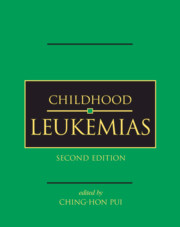Book contents
- Frontmatter
- Contents
- List of contributors
- Preface
- Part I History and general issues
- Part II Cell biology and pathobiology
- 4 Anatomy and physiology of hematopoiesis
- 5 Hematopoietic growth factors
- 6 Signal transduction in the regulation of hematopoiesis
- 7 Immunophenotyping
- 8 Immunoglobulin and T-cell receptor gene rearrangements
- 9 Cytogenetics of acute leukemias
- 10 Molecular genetics of acute lymphoblastic leukemia
- 11 Molecular genetics of acute myeloid leukemia
- 12 Apoptosis and chemoresistance
- 13 Heritable predispositions to childhood hematologic malignancies
- Part III Evaluation and treatment
- Part IV Complications and supportive care
- Index
- Plate Section between pages 400 and 401
- References
6 - Signal transduction in the regulation of hematopoiesis
from Part II - Cell biology and pathobiology
Published online by Cambridge University Press: 01 July 2010
- Frontmatter
- Contents
- List of contributors
- Preface
- Part I History and general issues
- Part II Cell biology and pathobiology
- 4 Anatomy and physiology of hematopoiesis
- 5 Hematopoietic growth factors
- 6 Signal transduction in the regulation of hematopoiesis
- 7 Immunophenotyping
- 8 Immunoglobulin and T-cell receptor gene rearrangements
- 9 Cytogenetics of acute leukemias
- 10 Molecular genetics of acute lymphoblastic leukemia
- 11 Molecular genetics of acute myeloid leukemia
- 12 Apoptosis and chemoresistance
- 13 Heritable predispositions to childhood hematologic malignancies
- Part III Evaluation and treatment
- Part IV Complications and supportive care
- Index
- Plate Section between pages 400 and 401
- References
Summary
Introduction
The cloning of receptors for most of the known cytokines and characterization of their functions have provided essential and, to some extent, unexpected insights into the mechanisms by which cytokines mediate their effects on cells. Cytokines have three broadly defined functions. (1) Many are essential for signaling the cell to proliferate and therefore interface directly with the cellular events that control or contribute to cell cycle progression and cell cycle checkpoints. (2) Many others induce cellular signals that contribute to the suppression of apoptosis. (3) Many cytokines regulate the expression of cell lineage- and maturation stage-specific genes that contribute directly to the events associated with differentiation or to the cellular functions that characterize a differentiated state. The continual challenge in understanding the biochemical consequences of ligand binding is to understand the significance of specific signaling pathways to these functions. As will become obvious in this chapter, the consequences of the activation of a signaling pathway are rarely known in precise terms.
Cytokines function through their interaction with cellular receptors that bind the cytokines with high affinity and, generally, become aggregated as a consequence of ligand binding. Cytokine receptors belong to structurally and functionally related families of proteins that can be defined by the initial type of biochemical reactions that are induced by ligand binding. Many of the ligands that affect hematopoietic cells utilize receptors that couple ligand binding to the induction of tyrosine phosphorylation.
- Type
- Chapter
- Information
- Childhood Leukemias , pp. 125 - 149Publisher: Cambridge University PressPrint publication year: 2006



